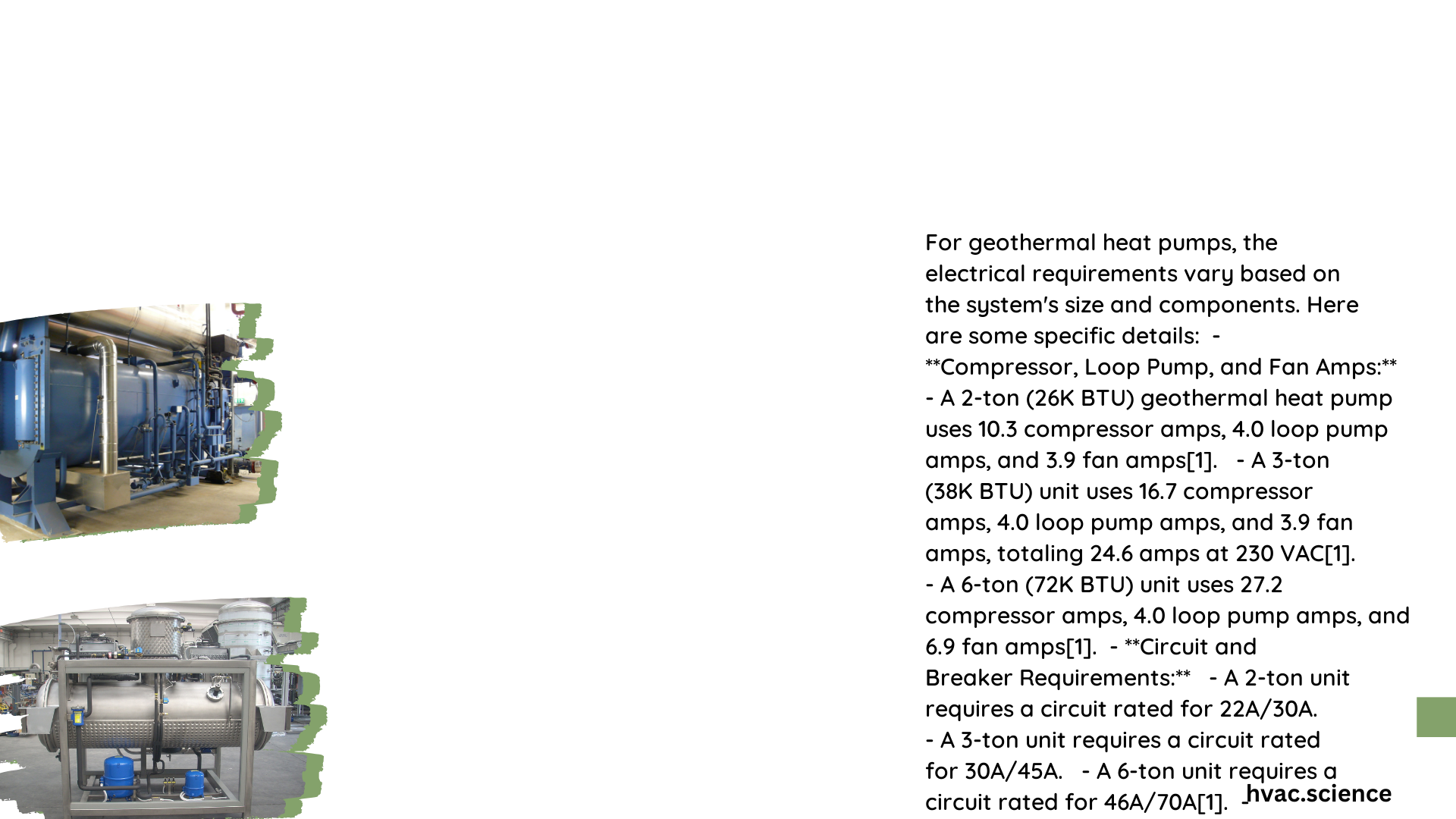Geothermal heat pump amps are a crucial aspect of system design and installation. These systems typically require between 10 to 30 amps for residential units, depending on size and model. Understanding amp ratings is essential for proper electrical setup, ensuring safety, and optimizing energy efficiency. This article explores the intricacies of geothermal heat pump amp requirements, their impact on performance, and how to maximize system efficiency.
What Are Typical Amp Ratings for Geothermal Heat Pumps?
Geothermal heat pump amp ratings vary based on the size and model of the unit. Here’s a breakdown of typical amp ratings for the ClimateMaster Tranquility 27 series:
| Unit Size | Compressor Amps | Loop Pump Amps | Fan Amps | Total Running Load |
|---|---|---|---|---|
| 2 Ton | 10.3 | 4.0 | 3.9 | 18.2A @ 230 VAC |
| 3 Ton | 16.7 | 4.0 | 3.9 | 24.6A @ 230 VAC |
| 4 Ton | 21.2 | 4.0 | 6.9 | 32.1A @ 230 VAC |
| 5 Ton | 25.6 | 4.0 | 6.9 | 36.5A @ 230 VAC |
| 6 Ton | 27.2 | 4.0 | 6.9 | 38.1A @ 230 VAC |
These figures illustrate that larger units generally require higher amp ratings to operate effectively.
How Do Amp Ratings Affect Electrical Installation?

Amp ratings directly influence the electrical installation requirements for geothermal heat pumps. Key considerations include:
- Circuit wiring
- Breaker size
- Fuse requirements
For example, the ClimateMaster Tranquility 27 series requires the following circuit wiring, breaker, or fuse specifications:
- 2 Ton: MIN/MAX of 22A/30A
- 3 Ton: MIN/MAX of 30A/45A
- 4 Ton: MIN/MAX of 38A/50A
- 5 Ton: MIN/MAX of 44A/60A
- 6 Ton: MIN/MAX of 46A/70A
Proper sizing of these components is crucial to ensure safe and efficient operation of the geothermal heat pump system.
What Challenges Arise from Geothermal Heat Pump Amp Requirements?
Several challenges can emerge when dealing with geothermal heat pump amp requirements:
-
High Starting Currents: Compressors often have high starting currents, which can be up to 5 times the running current. For instance, a 3 Ton unit may have a starting load of 82 Amps for the compressor.
-
Wiring and Breaker Sizing: Ensuring that wiring and breakers can handle both running and starting loads is critical to prevent electrical issues.
-
Supplemental Heat: Some systems require additional electrical connections for supplemental heat strips, increasing the overall electrical load and installation complexity.
-
Voltage Drop: Long wire runs may necessitate larger wire sizes to compensate for voltage drop, especially in rural installations.
How Can Power Consumption Be Optimized for Geothermal Heat Pumps?
Optimizing power consumption for geothermal heat pumps involves several strategies:
-
Proper Sizing: Accurately determine the heat pump size based on the home’s heating and cooling needs using methods like ACCA Manual J calculations.
-
Efficiency Ratings: Choose systems with high efficiency ratings such as Coefficient of Performance (COP), Energy Efficiency Ratio (EER), and Seasonal Energy Efficiency Ratio (SEER).
-
Soft Start Technology: Implement soft start capabilities to reduce starting currents and minimize electrical stress.
-
Regular Maintenance: Conduct routine maintenance on loop pumps, fans, and other components to ensure optimal efficiency.
-
Efficiency Certifications: Select systems certified by organizations like ARI/ASHRAE/ISO to ensure high efficiency standards.
What Impact Do Amp Ratings Have on System Efficiency and Operational Costs?
Amp ratings play a significant role in system efficiency and operational costs:
-
Power Consumption: Higher amp ratings generally indicate higher power consumption. For example, a 3 Ton unit with a total running load of 24.6A @ 230 VAC consumes approximately 5.7 kW.
-
Energy Bills: More efficient systems with lower amp requirements can lead to reduced energy bills over time.
-
Initial Costs: Higher amp ratings may require more robust electrical installations, potentially increasing initial setup costs.
-
Long-term Savings: While more efficient systems might have higher upfront costs, they often result in significant long-term energy savings.
How Do Geothermal Heat Pump Amps Compare to Traditional HVAC Systems?
Geothermal heat pumps often have lower amp requirements compared to traditional HVAC systems:
-
Energy Efficiency: Geothermal systems typically use 25-50% less electricity than conventional heating or cooling systems.
-
Consistent Performance: Geothermal heat pumps maintain steady efficiency regardless of outdoor temperature fluctuations, unlike air-source heat pumps.
-
Reduced Peak Loads: The lower amp requirements of geothermal systems can help reduce peak electrical loads on the grid.
-
Environmental Impact: Lower amp usage translates to reduced energy consumption and a smaller carbon footprint.
What Are the Best Practices for Managing Geothermal Heat Pump Amps?
To effectively manage geothermal heat pump amps:
-
Professional Assessment: Have a qualified HVAC professional assess your home’s specific needs and recommend an appropriately sized system.
-
Electrical Upgrades: Ensure your home’s electrical system can support the heat pump’s amp requirements, upgrading if necessary.
-
Monitoring Systems: Install energy monitoring systems to track power consumption and identify any efficiency issues.
-
Regular Maintenance: Schedule annual maintenance checks to keep the system operating at peak efficiency.
-
Insulation and Sealing: Improve your home’s insulation and seal air leaks to reduce the load on your geothermal system.
By understanding and properly managing geothermal heat pump amps, homeowners can ensure safe, efficient, and cost-effective operation of their heating and cooling systems. The initial investment in a well-designed and correctly sized geothermal system can lead to substantial energy savings and reduced environmental impact over the long term.
